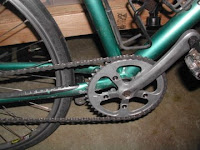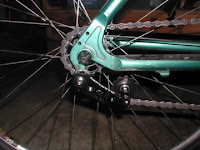I recently had to reduce the across the wire trips for the monitoring app I had hastily thrown together because the amount of time spent making trips serializing and deserializing individual resources was beginning to affect monitoring performance. The Second Fallacy of Distributed Computing was beginning to rear it's ugly Putinesque head.
I knew that this was coming, but premature optimization has never worked out for me, so I went with the default ActiveResource approach -- everything is a resource, and a CRUD operation on a resource maps to the corresponding http 'verb' -- until smoke started pouring out of my servers.
My basic requirements:
- Create a web service that can store data for hundreds of individual datapoints at 5 minute intervals.
- Those datapoints can come and go.
- The implementor of the statistics gathering code really doesn't need to know the by the wire details of how their data is getting to my web service.
- I shouldn't have to perform individual CRUD ops on each statistic every 5 minutes.
- I shouldn't have to make an over the wire request for data every time I want to read that data.
- I need to bulk upload statistics, and create/update them in one transaction in order to reduce the need for individual CRUD ops. At this point I'm going to choose to 'fail fast', aborting if a single create/update fails, so that I know if something is wrong.
- I need to keep a client side cache of those statistics around, only updating them when they've changed (important aside: because this is a monitoring application, it is assumed that each statistic belongs to a single client, so there is no need for out of band updates).
I'd love to go into a long digression about how I explored every which way to do this, but I'll summarize by saying that my final solution had the following advantages:
- Uses the existing ActiveResource custom method infrastructure
- No custom routes need to be defined
- Complexity hidden from the user, restricted to client side upload_statistics call and server side POST handler method.
- The priesthood of High REST will not need to crucify me at the side of the road.
I needed to extend default ActiveResource. By default, AR is not aware of data model relationships. For example, invoking the to_xml method on an AR class only shows it's attributes, even if you specify other classes to include, like this:
ARDerivedClass.to_xml(:include=>[childClass])
This limitation makes being smart about bulk updates pretty hard. I needed to introduce the notion of a client side cache, initialized and synchronized as needed.
My data model looks roughly like this:
Monitor=>has many=>Statistics
The default AR implementation of this looks like
class Statistic <>I've extended as follows:
- implemented an add_statistic method to Monitor that caches Statistic objects locally
- Added an upload_statistics method to the Monitor that serializes the client local statistics and then sends them to the server.
- modified the default POST handler for Statistic objects to handle bulk creates/updates.
- initially loaded the statistics cache on the client side.
- lazy synced the cache to the server side, updating on find and delete requests.
I want to point out a couple of things in this code:
(1) Cache loading is done in Monitor.initialize(). That way it gets called whether the client is retrieving or creating a Monitor.
def initialize(attributes = {}, logger = Logger.new(STDOUT))
if(@@logger == nil)
@@logger = logger
end
@statistics = {}
if(attributes["statistics"] != nil)
attributes["statistics"].each do | single_stat_attributes|
@@logger.debug("loading #{single_stat_attributes["name"]}")
@statistics[single_stat_attributes["name"]] = Statistic.new(single_stat_attributes)
end
end
super(attributes)
endThis required the following modification on the Monitor controller (server) side:
def index
if(params[:name] == nil)
@monitor_instances = Monitor.find(:all)
else
@monitor_instances = Monitor.find_all_by_name(params[:name])
end
respond_to do |format|
format.html #index.html.erb
format.xml { render :xml => @monitors.to_xml(:include=>[:statistics]) }
format.json { render :json => @monitors.to_json(:include=>[:statistics])}
end
end
I needed to make sure that returned monitor instances included child statistics in order to load the client side cache.
(2) get_statistic and delete_statistic synchronize with the server side.
(3) I've added a new upload_statistics method. I wanted to override save, but what I found at runtime is that the ActiveResource.save method calls update, which loads statistics as attributes. This wont work for us because some of those attributes may not exist on the server side, so an 'update' operation is invalid. In upload_statistics, a custom AR method posts the client side cache of statistics to the StatisticsController on the server side:
def upload_statistics
if(@statistics.length > 0)
data = @statistics.to_xml
self.post(:statistics,{:bulk=>"true"},data)
end
endNote that the first parameter is the method name, the second is the param options, and the third is the actual post data (that contains the serialized client side map of the statistics. The actual path that this POST gets sent to is /monitor_instances/:id/statistics.xml
In the server, I do not have to add/create any new routes, but I do need to make sure that the default POST handler checks for the bulk parameter and handles accordingly.
# POST /statistics
# POST /statistics.xml
def create
if(params[:bulk] == nil)
# handle a single update
else
#handle a bulk update
end
end
In the StatisticsController,create handler, I need to unmarshall the xml into statistics. There are these instructions to extend ActiveRecord via the standard lib/extensions.rb mechanism, but they won't work for me because I'm serializing a hash, not an array of Statistic objects. So I need to deserialize and create/update objects by 'hand', which actually isn't that hard:
cmd = request.raw_post
monitor_instance = MonitorInstance.find(params[:monitor_instance_id])
logger.debug(cmd)
hash = Hash.from_xml(cmd)
hash["hash"].values.each do | options |
stat = Statistic.find(:first,
:conditions=>["monitor_instance_id = #{params[:monitor_instance_id]} and name = '#{options["name"]}'"])
if(stat == nil)
#create a new Statistic object
else
# update existing statistic object
end
end
respond_to do |format|
statistics = Statistic.find(:all,
:conditions=>["monitor_instance_id = #{params[:monitor_instance_id]}"])
format.xml { render :xml => statistics.to_xml, :status => :created, :location => monitor_instance_path(@monitor_instance) }
end
To get to the original hash of statistics options, I had to extract them from the encoded hash:
hash = Hash.from_xml(cmd)
hash["hash"].values.each do | options |
# create / update the stat that corresponds to options["name"] under the monitor
end
This took a lot longer than expected, because I ran into issues with trying to use standard methods, i.e. save, that I still don't understand. However, I know a lot more about AR and how to extend it to do more intelligent sub resource handling.
![Reblog this post [with Zemanta]](http://img.zemanta.com/reblog_e.png?x-id=120f47df-199b-4537-9d6c-5742ee0481e4)





![Reblog this post [with Zemanta]](http://img.zemanta.com/reblog_e.png?x-id=60270abf-8834-4c22-aebf-0470125ae262)

![Reblog this post [with Zemanta]](http://img.zemanta.com/reblog_e.png?x-id=bfb9ad0c-3987-48e0-9b32-6db86c667f17)
![Reblog this post [with Zemanta]](http://img.zemanta.com/reblog_e.png?x-id=bdc0565d-590a-4c68-89d1-4d408201dc85)

![Reblog this post [with Zemanta]](http://img.zemanta.com/reblog_e.png?x-id=1be26964-2630-47e7-a230-57be38be4768)